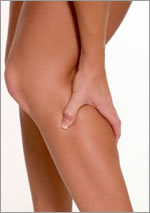
This question of the week is a question to me, rather than a question to you. Let me know your thoughts on the subject after reading the article.
Let me tell you about a recent conversation with one of my friends over IM. This guy used to lift with me back in college, but he’s working on his own business right now and hasn’t touched a weight in almost a year. So the guy goes out and gets a gym membership and starts training again last Monday.
This is how the conversation went down…
 my weightlifting friend: yo wtf
my weightlifting friend: yo wtf
friend: my muscles hurt
friend: so bad
me: bwahaha
friend: chest and tris are killing me
friend: since Monday
friend: I can barely move
me: nasty
me: don’t push it so hard the first week back foo
friend: I can’t help it
friend: and I didn’t push that hard
friend: I just did as much as I could
friend: which is not as much as it used to be
me: yeah
me: you prolly did negative reps
me: and pushed out every last rep out of every set
me: and tried to use the weights you used to use
me: haha
friend: haha
friend: whatever I did
friend: it sucks ass
friend: what can I do to recover faster?
My friend here is suffering from a little something called Delayed Onset Muscle Soreness, or DOMS.
What is DOMS?
DOMS is sore, stiff and painful feelings in muscles, which occur 24-48 hours following intense exercise. DOMS is almost always guaranteed to set in when an individual trains too hard during their first couple workouts after a long layoff. This discomfort is more prevalent following overloaded eccentric (the ‘negative’ portion of the rep) muscle activity, where the muscles are placed under a load that is typically too heavy to lift, or super-slow eccentric activity where the muscle fibers are forced to flex and contract at the same time.
A typical example is when the load becomes too heavy on a bench press, the spotter lifts the weight for the trainee, and lowers it slowly under control. This just tears up and really damages muscle fibers.
The following are thought to be responsible for DOMS:
- Small tears in the muscle or connective tissues between the fibers, usually from excessive intensity or eccentric training.
- Overly aggressive exercise by an untrained individual or by a detrained athlete, in the initial stages of a new program.
- Muscle spasms or cramping, which may starve the muscle of the nutrients it needs to recover.
- Dehydration during and after a workout. Be sure to drink your electrolyte fluids!
- The build up of lactic acid and other waste product production during training. Many experts agree that lactic acid has nothing to do with DOMS, but it may contribute a small amount due to lactic acid accumulation hindering delivery of essential nutrients to the muscles.
How to Prevent DOMS
The first basic rule of recovering from DOMS is to be pro-active in preventing DOMS in the first place.
Take these steps to prevent DOMS:
- Drink an electrolyte-based fluid during your workout. Gatorade is the most popular.
- Drink a post-workout drink within 20 minutes of the end of your workout. I recommend Biotest Surge.
- Warm up for a couple minutes prior to intense exercise.
- Cool down and stretch for 10-15 minutes after intense exercise.
- Avoid forced negative reps.
- Avoid super slow negative reps.
- Avoid assisted negative reps. (get the idea?)
- Take it easy during your first week of training, or your first week back to training after a layoff.
How to Recover from DOMS
If you are not able to avoid DOMS and now must suffer through it for a couple days.
Here are a couple ways to get through DOMS faster:
- Light exercise to stimulate blood flow. Either cardio exercise or weightlifting with very light weights.
- Time. The pain will go away after a couple days.
- Gentle massage, or better yet deep tissue massage.
- Alternating hot and cold showers. 2 minutes each.
- Alternating hot pack / ice pack treatments. 5 minutes each.
- Ice cube massage or ice bath. =)
- Hydrotherapy or spa baths.
- Use a foam roller on the sore areas.
If you are lifting with the proper intensity, you will ultimately experience DOMS on one occasion or another. By taking steps to both prevent and treat DOMS, you should be able to minimize the pain. Best of luck!











I like a lot of what Steve and Chris are saying, but let me add.
When I’m getting back into training there is nothing that I’ve ever found more valuable than a good cold pack.
Use it right after you get home from the gym. One round of 15, or 15 then 20 off then another 15. This heads off so many DOMS issues it’s not funny.
It’s the muscles that I don’t ice that develop it. Really.
It’s not been as much of an issue for me with muscles that are already toned.
Max, I’ve got a couple thoughts on your legs. First, the above. Second, it could be just because these are large muscles (and are you talking about your hams? – sitting too much is terrible for them). Third, I just have to ask you to check if maybe you just need to work on toning for a while.
Hiya, why is it that that DOMS is always so much worse in my legs than anywhere else? After squatting I can never put my socks on the following day
That’s because leg training is hardcore. Sounds like you lift with intensity. Good for you!
The best way to get rid of DOMS is to never get it in the first place. I try to decrease the intensity of my workout when I switch up my routine. This way I am ready for the next scheduled workout and my motivation is still high.
Thanks for the advice to all these people and Steve you answered a lot of the questions i would have asked.
I recently got back in the gym last week and now everyday the pain is worse and worse and i never understood why and what it was until now i’ve gone through this page.
DOMS has messed up my weekend, next week i will take it easier than this last week, i cant have another weekend wasted feeling like a B*#ch..
I’ve always believed that without DOMS after your workout, its been a wasted exercise, as you need those muscle tears in order to build fresh new and stronger/bigger muscle. Without DOMS, you have not damaged the muscle enough for your body to repair anything. Is my thinking completely wrong ?
Most people think this is true, but it’s not. For an experienced lifter, excessive DOMS means you have done too much damage to your muscles, which slows recovery. Some soreness is OK, but you may get better results by not pushing it quite so hard, by which I don’t mean you should decrease intensity, but back off on training to failure and using negative or forced reps. These techniques are good occasionally, but should not be used on every exercise at every workout. Less DOMS means quicker recovery and increased training frequency.
Thats interesting Steve, I normally workout bi/tri/chest/abs one day, upper back/shoulders next day, lower back/legs next day, CV the next day and so on, I change the routine ever so slightly and regularly so that my body doesnt get used to it. I’ve never managed to not have DOMS the next day, I always finish my sets and reps and as time goes on I put on bigger weights (as you do). When you say ‘to failure’ to me that means lifting till you basically cant lift no more with that targeted muscle group. If that is true, then there is no way of getting away from DOMS, as I push myself to ‘failure’ – Should I be dropping weight ? Or what would you recommend ?
Maybe you go to failure too often. When you do 3 sets of any exercise, there is really no need to go to failure until the final set. Here is one way to structure your weights and reps:
Set 1 should be close to your work weight, leaving a couple reps in the bag.
Set 2 should be your work weight where you go until the rep is really hard, but don’t push it so hard that you need extra help or you fail to complete the rep.
Set 3 should be the set where you push it by adding a little more weight or attempt to eek out one additional rep. It is OK to struggle on the last rep. This would be the set to take to failure.
You will be sore from DOMS on a regular basis, but it should only be a 24-48 hour light soreness that should be alleviated by light stimulation of the target muscle. Severe DOMS that lasts more than 48 hours means you can probably scale back your sets, exercises, or reps a little bit so that you can train the target muscle group with more frequency, which will definitely give you more gains in less time.
Hi
Is DOMS a serious problem then cause i’ve always suffered from it?? i know it sounds strange but i kinda like it, makes me know ive really trained hard.
do i need to try and stop it??
Adam: DOMS is not a serious problem. Everyone suffers from it. Less DOMS is better, but it won’t hurt you.
[…] Warm up stretches & warm up exercises for a power workout routine Easy warm up exercises How to recover from Delayed Onset Muscle Soreness (DOMS) Ballistic stretching – Danerous or not? Training, Treadmill, exercise, weight […]
Hi ive been training for a rugby league team recently and i need some tips on how to recover im currently bench pressing 90Kg and walk lunging 80kgs i need help to recover faster so i can do more training thank you. get back 2 me please.
Hi Andy. My first question is: did you read this post?
I will reprint the section you are looking for:
If you are not able to avoid DOMS and now must suffer through it for a couple days, here are a couple ways to get through it faster:
* Light exercise to stimulate blood flow. Either cardio exercise or weightlifting with very light weights.
* Time. The pain will go away after a couple days.
* Gentle massage, or better yet deep tissue massage.
* Alternating hot and cold showers. 2 minutes each.
* Alternating hot pack / ice pack treatments. 5 minutes each.
* Ice cube massage or ice bath. =)
* Hydrotherapy or spa baths.
* Use a foam roller on the sore areas.
And one tip I didn’t mention before: sleep. If you aren’t sleeping enough your body will haunt you with soreness and nagging injuries. Trust me, I am the poster boy for sleep deprivation. It totally kills your workout recovery. I need and recommend 8 hours a night, although everyone’s real requirements will vary.
Best of luck!
[…] of oxidants. This results in damage that contributes to muscular fatigue during and after exercise. Delayed Onset Muscle Soreness (DOMS), which is an inflammatory response that occurs typically within 24 hours after strenuous exercise, […]
I’m in day two of recovering, and I’ve managed to work out so hard, I have to walk around like Mr. Burns. I can’t straighten out my elbows, lift my arm over my head, o reven wipe my own @$$ without cringing in pain. But, I think the worst is over. Yesterday, my arms felt like I just slept wrong, but this morning, the pain was there. It hurt so bad I almost cried like Nancy Karrigan. But now that the day’s over, I’ve taken another shower, walked laps in my pool, and I’m ready to go to bed now. New routines are nothing to mock.
I am still suffering from DOMS since Monday. Today is Friday. This is the longest I’ve ever had to deal with such soreness after getting back in the gym, but then again, it’s also the longest I’ve ever gone without going to the gym.
Serves me right.
Yeah definitely. If I were you I would have trained with less intensity a week before a big event. In my opinion you are better off observing active recovery / competition-prep the week before the competition. Sorry to hear about your knee.
This year before track, I got into lifting heavy again after a month or so off… and i did heavy squats the week before track. The DOMS and the minor knee problem I have added up to no running the second week of track… makes me wonder if I could have taken 2nd in the conference instead of 4th at the end of the season had I taken it easy in the gym.
Cool info! 🙂